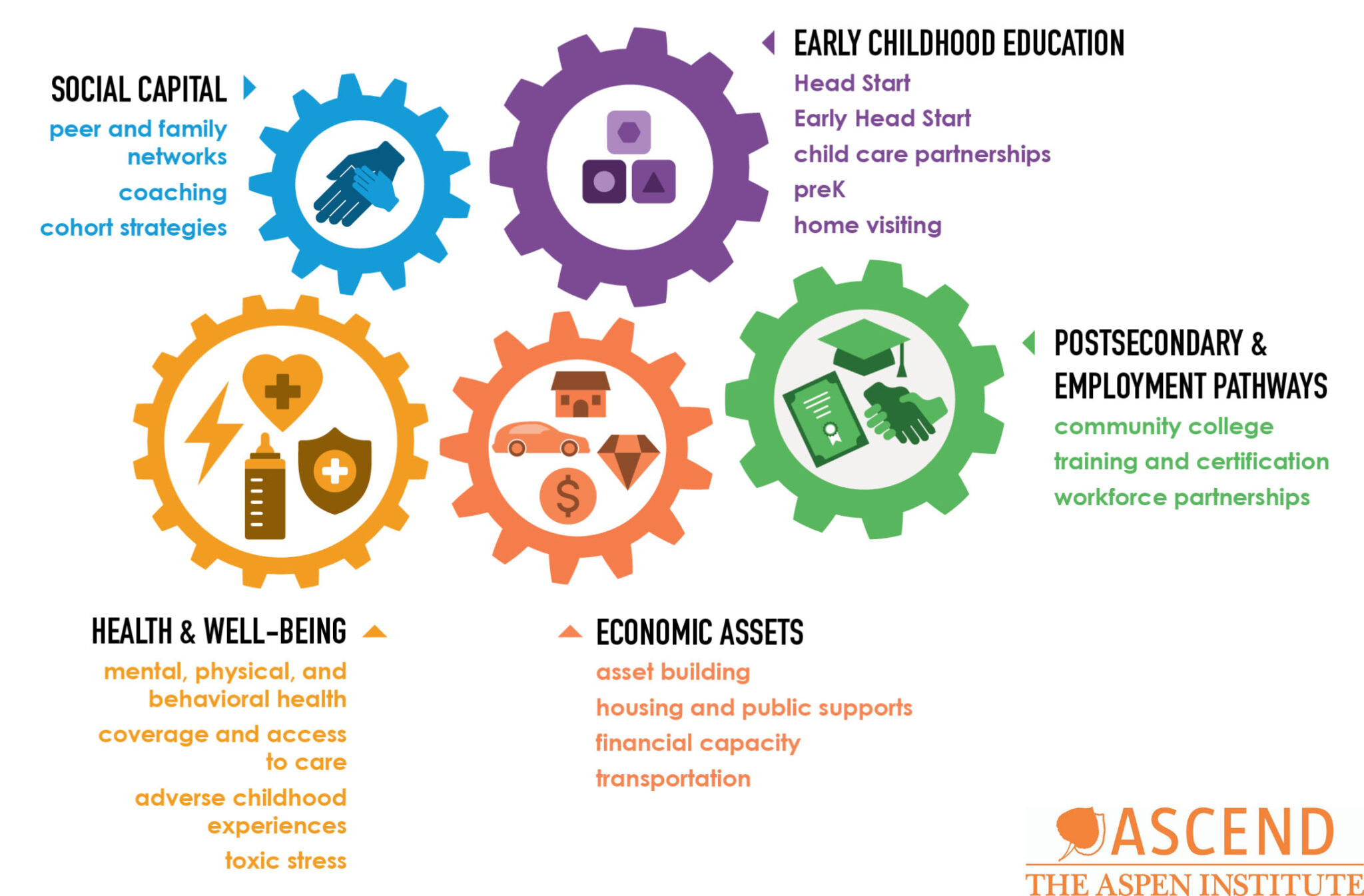Two-Generation Approach
- What is 2Gen?
- Why use a 2Gen Approach?
- Core Components of 2Gen Family Well-Being
- Hallmarks of a 2Gen Approach
- 2Gen Seeks Scale
Two-generation (2Gen) approaches build family wellbeing by intentionally and simultaneously working with children and the adults in their lives together. As children, parents, and families grow and change across their lifespan, 2Gen approaches align opportunities to help families pursue their goals and thrive, optimizing each person’s potential along the way. The results are healthy parents with family-supporting jobs, healthy children meeting developmental milestones, and better-connected individuals able to participate in civic and family life
Communities do better if everyone achieves their full potential. Two-generation approaches help achieve that goal and ensure that everyone can contribute to the community and the economy. Family members don’t live in a vacuum. What happens in one generation affects the other, both positively and negatively. That’s why the 2Gen approach helps adults and the children in their lives set whole-family goals and work on them together. It is a common-sense strategy. By generating a legacy of family well-being that passes from one generation to the next, 2Gen helps communities become stronger and more vibrant, socially and economically
The 2Gen approach helps families achieve five different aspects of family well-being.
- Physical and mental health. Health has a major impact on a family’s ability to thrive. If a child is unwell, it can affect attendance and learning in school. A parent’s illness can affect their ability to earn or perform at work – and to be the good parents they want to be. Moreover, research shows children experience spectacular brain development in their early years, and that new parents undergo major brain structure changes just as babies do. Steady emotional development – and the treatment of any trauma or stress throughout family life – are critical to ensuring families get off to a good start and progress.
- Early childhood education. Research from Nobel winning economist James Heckman indicates each year of high-quality early childhood education produces a 13 percent return on investment in that child’s future earnings. That’s why 2Gen efforts strive to ensure that all services and programs for young children – including childcare, Head Start, home visits, K-12 education, and activities with their parents and guardians – include state-of-the-art content and meet proven high-quality standards.
- Postsecondary and employment pathways. Education boosts family well-being. A parent’s educational level is a strong predictor of a child’s success. Parents who complete a college degree double their lifetime incomes, adding to the financial security of their families. Two-generation approaches help parents and adult caregivers achieve education milestones and training certifications that lead to better jobs and careers.
- Economic Assets. A $3,000 difference in parental income when their child is young is associated with a 17 percent increase in the child’s future earnings. Striving families with low incomes face daunting costs for housing, transportation, education, food, health care – and more. Two-generation approaches help parents increase economic security and income by helping them reduce costs, access available financial assistance, and build assets over time.
- Social Capital. To get ahead in life, both adults and children need helpful connections to people and information – and need opportunities to both give and receive support. Building a family’s “social capital” network is a key component in a successful 2Gen approach. Years of research have shown that social capital connections produce for both families and community – as peer support, stronger neighborhoods, more participation in community and faith-based organizations, and school and workplace advances.
To help parents and children set, pursue, and achieve their family goals, 2Gen approaches include the following hallmark characteristics:
- Center on families. Two-generation approaches engage and listen to families as equal partners in setting and achieving family goals. Family expertise and advice drive the design of 2Gen services.
- Integrate services. Two-generation approaches find common-sense ways to align the location and timing of parent and children activities, to provide a range of services at one-stop locations, and eliminate any duplicative hoops to access and participation that families must jump through.
- Remove barriers. Two-generation approaches persistently identify long-standing and emerging barriers that keep families from participating in programs and activities to meet their whole family goals – and work to redesign systems or find partners to remove those barriers.
- Coach. Two-generation approaches deploy frontline staff as family coaches who help families set goals and develop solutions, rather than as case managers who only offer standard referrals or doing the work themselves.
- Partner. Two-generation efforts require committed and creative partnerships – with organizations, businesses, educational institutions, governments, and philanthropic investors – in order to offer families a comprehensive range of services that are targeted and timed to help them reach their full potential.
- Commit to racial equity. Two-generation approaches look at practices and policy – their own, their civic and education institutions, their local industries and government at all levels – to spot and tear down structural barriers that families of color or varying cultures face in accessing services, training, and employment.
- Measure family outcomes. Two-generation approaches develop ways to measure family progress and well-being outcomes for children, their parents, and their adult guardians. When an effort succeeds in putting these 2Gen hallmarks in place, it fundamentally changes the way the lead organizations and partners operate. The organizational culture shifts. Staff engage differently with parents, listening and coaching as families create their own paths to well-being. Program leaders organize their work around what families experience, rather than around what funding streams or program categories allow. Staff and families redesign, and intentionally link services (and align funding streams) to create a seamless, integrated set of high-quality child and adult services. Most important, adults and children accelerate their progress towards their family goals and dreams.
Rigorous, continuous improvement is also a cornerstone of 2Gen approaches and the developing 2Gen field. Many 2Gen services are governed by state and federal policy – or by employer practices. These policies can either hinder or help adult and child programs work together efficiently and effectively for families. As 2Gen programs learn, they inform new and better policies to improve family and community well-being nationwide.
Understanding 2Gen was produced by Ascend at the Aspen Institute and the Aspen Institute Community Strategies Group as part of 2GenACT, in collaboration with the Annie E. Casey and W.K. Kellogg Foundations. To learn more about Ascend at the Aspen Institute and two-generation approaches, visit: http://ascend.aspeninstitute.org


